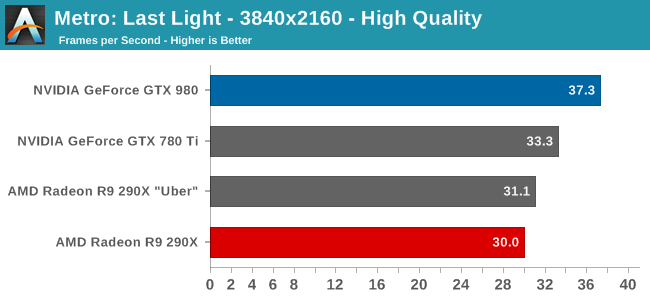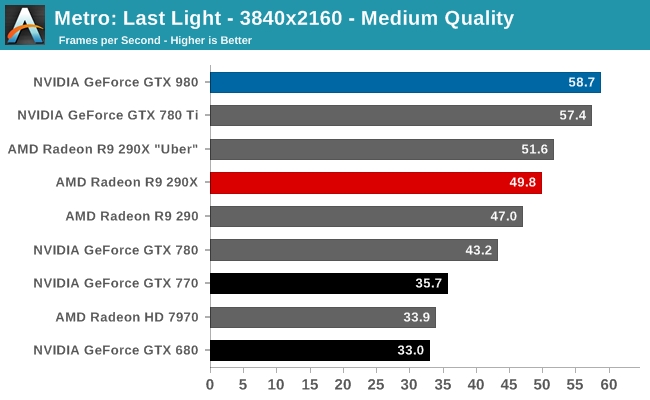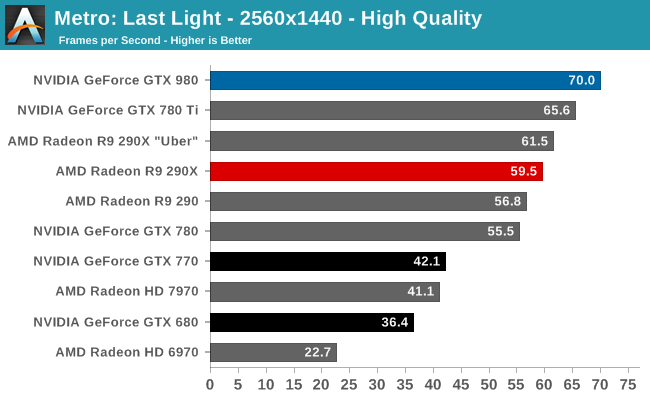The NVIDIA GeForce GTX 980 Review: Maxwell Mark 2
by Ryan Smith on September 18, 2014 10:30 PM ESTMetro: Last Light
As always, kicking off our look at performance is 4A Games’ latest entry in their Metro series of subterranean shooters, Metro: Last Light. The original Metro: 2033 was a graphically punishing game for its time and Metro: Last Light is in its own right too. On the other hand it scales well with resolution and quality settings, so it’s still playable on lower end hardware.




As has become customary for us for the last couple of high-end video card reviews, we’re going to be running all of our 4K video card benchmarks at both high quality and at a lower quality level. In practice not even GTX 980 is going to be fast enough to comfortably play most of these games at 3840x2160 with everything cranked up – that is going to be multi-GPU territory – so for that reason we’re including a lower quality setting to showcase just what performance looks like at settings more realistic for a single GPU.
GTX 980 comes out swinging in our first set of benchmarks. If there was any doubt that it could surpass the likes of R9 290XU and GTX 780 Ti, then this first benchmark is a great place to set those doubts to rest. At all resolutions and quality settings it comes out on top, surpassing NVIDIA’s former consumer flagship by anywhere from a few percent to 12% at 4K with high quality settings. Otherwise against the R9 290XU it’s a consistent 13% lead at 2560 and 4K Medium.
In absolute terms this is enough performance to keep its average framerates well over 60fps at 2560, and even at 3840 Medium it comes just short of crossing the 60fps mark. High quality mode will take the wind out of GTX 980’s sails though, pushing framerates back into the borderline 30fps range.
Looking at NVIDIA’s last-generation parts for a moment, the performance gains over the lower tier GK110 based GTX 780 are around 25-35%. This is about where you’d expect to see a new GTX x80 card given NVIDIA’s quasi-regular 2 year performance upgrade cadence. And when extended out to a full 2 years, the performance advantage over GTX 680 is anywhere between 60% and 92% depending on the resolution we’re looking at. NVIDIA proclaims that GTX 980 will achieve 2x the performance per watt of GTX 680, and since GTX 980 is designed to operate at a lower TDP than GTX 680, as we can see it means performance over GTX 680 won’t quite be doubled in most cases.










274 Comments
View All Comments
Kutark - Sunday, September 21, 2014 - link
I'd hold on to it. Thats still a damn fine card. Honestly you could probably find a used one on ebay for a decent price and SLI it up.IMO though id splurge for a 970 and call it a day. I've got dual 760's right now, first time i've done SLI in prob 10 years. And honestly, the headaches just arent worth it. Yeah, most games work, but some games will have weird graphical issues (BF4 near release was a big one, DOTA 2 doesnt seem to like it), others dont utilize it well, etc. I kind of wish id just have stuck with the single 760. Either way, my 2p
SkyBill40 - Wednesday, September 24, 2014 - link
@ Kutark:Yeah, I tried to buy a nice card at that time despite wanting something higher than a 660Ti. But, as my wallet was the one doing the dictating, it's what I ended up with and I've been very happy. My only concern with a used one is just that: it's USED. Electronics are one of those "no go" zones for me when it comes to buying second hand since you have no idea about the circumstances surrounding the device and seeing as it's a video card and not a Blu Ray player or something, I'd like to know how long it's run, it's it's been OC'd or not, and the like. I'd be fine with buying another one new but not for the prices I'm seeing that are right in line with a 970. That would be dumb.
In the end, I'll probably wait it out a bit more and decide. I'm good for now and will probably buy a new 144Hz monitor instead.
Kutark - Sunday, September 21, 2014 - link
Psshhhhh.... I still have my 3dfx Voodoo SLI card. Granted its just sitting on my desk, but still!!!In all seriousness though, my roommate, who is NOT a gamer, is still using an old 7800gt card i had laying around because the video card in his ancient computer decided to go out and he didnt feel like building a new one. Can't say i blame him, Core 2 quad's are juuust fine for browsing the web and such.
Kutark - Sunday, September 21, 2014 - link
Voodoo 2, i meant, realized i didnt type the 2.justniz - Tuesday, December 9, 2014 - link
>> the power bills are so ridiculous for the 8800 GTX!Sorry but this is ridiculous. Do the math.
Best info I can find is that your card is consuming 230w.
Assuming you're paying 15¢/kWh, even gaming for 12 hours a day every day for a whole month will cost you $12.59. Doing the same with a gtx980 (165w) would cost you $9.03/month.
So you'd be paying maybe $580 to save $3.56 a month.
LaughingTarget - Friday, September 19, 2014 - link
There is a major difference between market capitalization and available capital for investment. Market Cap is just a rote multiplication of the number of shares outstanding by the current share price. None of this is available for company use and is only an indirect measurement of how well a company is performing. Nvidia has $1.5 billion in cash and $2.5 billion in available treasury stock. Attempting to match Intel's process would put a significant dent into that with little indication it would justify the investment. Nvidia already took on a considerable chunk of debt going into this year as well, which would mean that future offerings would likely go for a higher cost of debt, making such an investment even harder to justify.While Nvidia is blowing out AMD 3:1 on R&D and capacity, Intel is blowing both of them away, combined, by a wide margin. Intel is dropping $10 billion a year on R&D, which is a full $3 billion beyond the entire asset base of Nvidia. It's just not possible to close the gap right now.
Silma - Saturday, September 20, 2014 - link
I don't think you realize how many billion dollars you need to spend to open a 14 nm factory, not even counting R&D & yearly costs.It's humongous, there is a reason why there are so few foundries in the world.
sp33d3r - Saturday, September 20, 2014 - link
Well, if the NVIDIA/AMD CEOs is blind enough and cannot see it coming, then intel are gonna manufacture their next integrated graphics on a 10 or 8 nm chip and though immature will be a tough competition to them in terms of power and efficiency and even weight.remember currently pcs load integrated graphics as a must by intel and people add third party graphics only 'cause intels is not good enough literally adding weight of two graphics cards (Intels and third partys) to the product. Its all worlds apart more convenient when integrated graphics outperforms or able to challenge third party GPUs, we would just throw away NVIDIA and guess what they wont remain a monopoly anymore rather completely wiped out
Besides Intels integrated graphics are getting more mature in terms of not just die size with every launch, just compare 4000s with 5000s, it wont be long before they catch up.
wiyosaya - Friday, September 26, 2014 - link
I have to agree that it is partly not about the verification cost breaking the bank. However, what I think is the more likely reason is that since the current node works, they will try to wring every penny out of that node. Look at the prices for the Titan Z. If this is not an attempt to fleece the "gotta have it buyer," I don't know what is.Ushio01 - Thursday, September 18, 2014 - link
Wouldn't paying to use the 22nm fabs be a better idea as there about to become under used and all the teething troubles have been fixed.